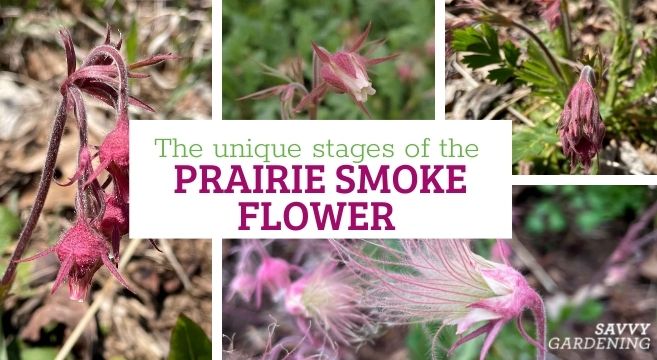This post may contain affiliate links. If you make a purchase through links on our site, we may earn a commission.
A “Native Plant of the Month” club introduced me to the various unique stages of the prairie smoke flower. There are the vibrant red buds that first appear in spring, followed by small white-ish flowers. Then, when the blooms fade, they form these feathery, fuzzy seed heads that look like something out of a cartoon. I love the whimsy and texture they add to the garden—a favorite, for sure. In this article, I’m going to share some growing tips for prairie smoke flowers, so you can enjoy their blooms in your own garden.
Prairie smoke (Geum triflorum) is native to parts of North America, including Ontario, the province where I live. It is also widespread across other areas of southern Canada, and the central and northern United States. Hardy down to USDA zone 3, drought tolerant, and low maintenance, prairie smoke is deer and rabbit resistant (perfect for my garden).
In the wild, plants grow in prairie settings, fields, and open areas, and are among the first prairie plants to bloom. They can also be found in rare ecosystems called alvars, which are comprised of shallow soils on limestone bedrock. Prairie smoke is a popular plant choice for rock gardens, which offer similar conditions. And it’s a great pollinator plant, attracting beneficial insects, like native bees.
Part of the rose (Rosaceae) family, other common names for prairie smoke include three-flowered Avens and old man’s whiskers.

What’s unique about the prairie smoke flower?
When I first planted my prairie smoke, I made note of where the hairy, fern-like leaves were in the fall, excited that the plant would reveal its pinkish-red, droplet-like buds come spring. My plants bloom around late April, early May. The flower buds grow three to a stem and the sepals are fused, so they don’t open completely. You have to get up close to admire the flowers. And it takes some effort for the bumblebees to find their way in.

What I find so interesting about prairie smoke is that the flowers point downwards or sideways, like columbine, but then the stems turn towards the sky to form their seed heads. These, in my opinion, are really the star of the show—and the reason I really wanted this plant in my garden. Those bashful blooms become eye-catching, wispy tufts of “smoke” that are silvery white with streaks of pink. They are so much more interesting than the flowers (sorry, blooms!). The tops remind me of certain types of ornamental grasses, but obviously with different foliage underneath. The fluffy plumes, called achenes, will sway in the wind, eventually scattering their seeds.
Planting prairie smoke
When choosing a location for prairie smoke, make sure the area has good drainage. If the plants sit in too much water, they can be susceptible to root rot. Keep in mind how the area drains in winter, too.
The soil of your site can be loam or sandy loam. A little bit of clay in the loam is okay, too. And because they thrive in alvars, prairie smoke may do well in the gravelly soils of a rock garden or scree garden, too. Plants can be grown in partial shade to full sun. They don’t like competition, so give them some space to flourish. Plant in front of taller plants, like in a border, so those telltale seed heads can be admired.

The plants can spread over time, via underground rhizomes, forming a wider mass of groundcover. Once established, these plants are drought tolerant. But be mindful of checking if they need watering during that first growing season.
Prairie smoke leaves, with their fuzzy hairs, can grow to be about 6 to 10 inches (15 to 25 centimeters) tall. They can look a bit peaked in the summer, with the heat and dryness, but bounce back in the fall. Eventually they’ll change to a reddish purple hue. Flower stems can reach 12 to 18 inches (30.5 to 45 centimetres) in height.

A prairie smoke flower can self-seed in the garden. Keep an eye out for seedlings. If you do source seeds, they can be winter sown outdoors.
Find other native plants for your garden
- White aster varieties for late-season blooms
- Host plants for native butterflies
- The best varieties of perennial sunflowers
- Fall-blooming Aster ‘Purple Dome’
- Native species of Rudbeckia




I want some of theses flowers, how do I start them and I live in Tennessee
Hi Jody, I would look into plant nurseries that sell native plants in your state. To be honest, I’m not sure if they’re native to Tennessee as I can’t find a source for them in the state.